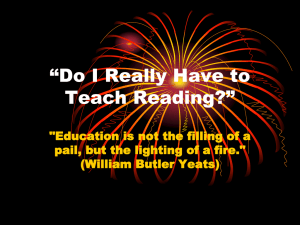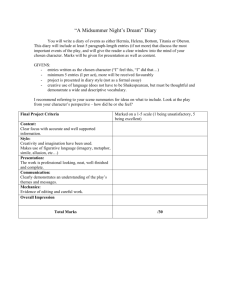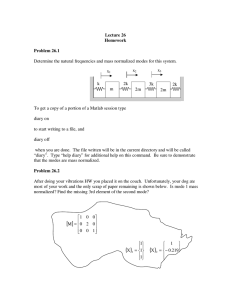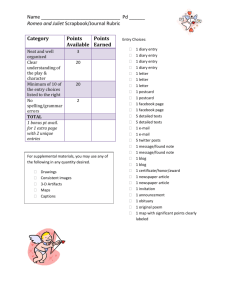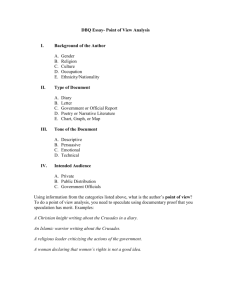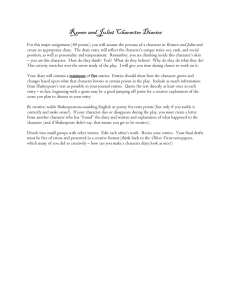Smart Diary: the Narrative of Your Daily Life
advertisement
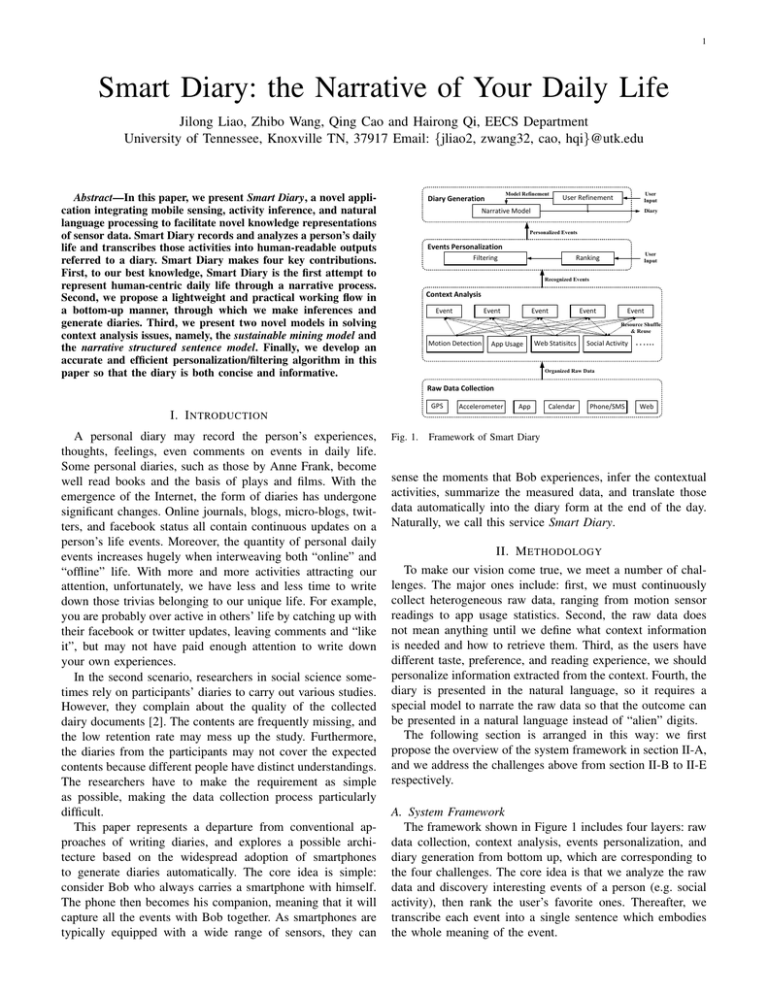
1
Smart Diary: the Narrative of Your Daily Life
Jilong Liao, Zhibo Wang, Qing Cao and Hairong Qi, EECS Department
University of Tennessee, Knoxville TN, 37917 Email: {jliao2, zwang32, cao, hqi}@utk.edu
Abstract—In this paper, we present Smart Diary, a novel application integrating mobile sensing, activity inference, and natural
language processing to facilitate novel knowledge representations
of sensor data. Smart Diary records and analyzes a person’s daily
life and transcribes those activities into human-readable outputs
referred to a diary. Smart Diary makes four key contributions.
First, to our best knowledge, Smart Diary is the first attempt to
represent human-centric daily life through a narrative process.
Second, we propose a lightweight and practical working flow in
a bottom-up manner, through which we make inferences and
generate diaries. Third, we present two novel models in solving
context analysis issues, namely, the sustainable mining model and
the narrative structured sentence model. Finally, we develop an
accurate and efficient personalization/filtering algorithm in this
paper so that the diary is both concise and informative.
Model Refinement
Diary Generation
User
Input
User Refinement
Narrative Model
Diary
Personalized Events
Events Personalization
Filtering
User
Input
Ranking
Recognized Events
Context Analysis
Event
Event
Event
Event
Event
Resource Shuffle
& Reuse
Motion Detection
App Usage
Web Statisitcs
Social Activity
…...
Organized Raw Data
Raw Data Collection
GPS
I. I NTRODUCTION
A personal diary may record the person’s experiences,
thoughts, feelings, even comments on events in daily life.
Some personal diaries, such as those by Anne Frank, become
well read books and the basis of plays and films. With the
emergence of the Internet, the form of diaries has undergone
significant changes. Online journals, blogs, micro-blogs, twitters, and facebook status all contain continuous updates on a
person’s life events. Moreover, the quantity of personal daily
events increases hugely when interweaving both “online” and
“offline” life. With more and more activities attracting our
attention, unfortunately, we have less and less time to write
down those trivias belonging to our unique life. For example,
you are probably over active in others’ life by catching up with
their facebook or twitter updates, leaving comments and “like
it”, but may not have paid enough attention to write down
your own experiences.
In the second scenario, researchers in social science sometimes rely on participants’ diaries to carry out various studies.
However, they complain about the quality of the collected
dairy documents [2]. The contents are frequently missing, and
the low retention rate may mess up the study. Furthermore,
the diaries from the participants may not cover the expected
contents because different people have distinct understandings.
The researchers have to make the requirement as simple
as possible, making the data collection process particularly
difficult.
This paper represents a departure from conventional approaches of writing diaries, and explores a possible architecture based on the widespread adoption of smartphones
to generate diaries automatically. The core idea is simple:
consider Bob who always carries a smartphone with himself.
The phone then becomes his companion, meaning that it will
capture all the events with Bob together. As smartphones are
typically equipped with a wide range of sensors, they can
Fig. 1.
Accelerometer
App
Calendar
Phone/SMS
Web
Framework of Smart Diary
sense the moments that Bob experiences, infer the contextual
activities, summarize the measured data, and translate those
data automatically into the diary form at the end of the day.
Naturally, we call this service Smart Diary.
II. M ETHODOLOGY
To make our vision come true, we meet a number of challenges. The major ones include: first, we must continuously
collect heterogeneous raw data, ranging from motion sensor
readings to app usage statistics. Second, the raw data does
not mean anything until we define what context information
is needed and how to retrieve them. Third, as the users have
different taste, preference, and reading experience, we should
personalize information extracted from the context. Fourth, the
diary is presented in the natural language, so it requires a
special model to narrate the raw data so that the outcome can
be presented in a natural language instead of “alien” digits.
The following section is arranged in this way: we first
propose the overview of the system framework in section II-A,
and we address the challenges above from section II-B to II-E
respectively.
A. System Framework
The framework shown in Figure 1 includes four layers: raw
data collection, context analysis, events personalization, and
diary generation from bottom up, which are corresponding to
the four challenges. The core idea is that we analyze the raw
data and discovery interesting events of a person (e.g. social
activity), then rank the user’s favorite ones. Thereafter, we
transcribe each event into a single sentence which embodies
the whole meaning of the event.
2
B. Raw Data Collection
er
th
k
e
ea
w
n
ru
al
w
iv
dr
t
si
n
e
k
al
ru
w
Given the personalized events, in this stage, we generate
diaries by mapping the events to sentences. The process model,
specifically called the narrative structured sentence model, has
a dictionary of sentences, each of which expresses the same
meaning as the event does, but having some fields replaced
by wild cards. Each wild card symbol corresponds to a field
of information in an event (e.g. time and numbers) so that
the event’s information can be filled back into the sentence
to form a complete sentence. Multiple structured sentences
can be used for one event because an event’s meaning can be
expressed in multiple ways.
iv
E. Diary Generation
dr
The event personalization layer, basically, ranks the user’s
most interesting events. Two major modules are involved:
ranking and filtering. The ranking module relies on the inherent importance among events (e.g. frequency and entropy) and
user preference to assign scores. Then the filtering module runs
a fast and memory-saving algorithm to select all the candidate
events. Finally, the filtered events are handed over to the diary
generation layer.
precision
recall
metero score
f-mean
Sentence category
(a) The motion activity recognition
performance
Fig. 3.
100
90
80
70
60
50
40
30
20
10
0
precision
recall
100
90
80
70
60
50
40
30
20
10
0
t
D. Event Personalization
The user interface screenshot of smart diary
si
The context analysis is a layer that is used to extract
many different types of knowledge from raw data. As the
user’s expectations are dissimilar and unpredictable, it is hard
for us to generalize data mining rules to represent users’
life styles. Therefore, we propose a novel model called the
sustainable mining model that decomposes a mining component (e.g. social activity) into several unique resource units.
The resource units perform singular extracting tasks such
as motion detection from accelerometer data, among others.
Those resource units are shared with all mining components
to reduce the system complexity and redundancy. If a new
mining component is added, we only need to implement the
extra resource units that do not currently exist. The output
of context analysis will be those events generated from the
respective mining components.
Fig. 2.
Scores (%)
C. Context Analysis
(a) main screen (b) user options (c) diary output (d) user preference
Score (%)
In this layer, we obtain comprehensive user profiles through
the following data sources: first, motion activities as measured
by accelerometer readings, providing us with information
about the user’s motion activities such as driving, walking,
sitting, and playing games; second, location information,
which offers us opportunities to find the user’s personal places,
commuting routes, and working locations; third, app usage,
which helps us identify a person’s behaviors, social activities
and personal interests; finally, the phone call/SMS history,
which leaves hints on the user’s “off-line” social groups and
real-life connectivity.
(b) The language quality score
Preliminary performance results.
III. P RELIMINARY R ESULTS
We implement the system on the Android smartphone and
have obtained some preliminary experiment results. Figure 2
illustrates the user interface on the smartphone.
In addition, we evaluate the performance of our motion
activity inference and the language quality of the diary. Figure 3(a) shows that the motion activity recognition has a very
high precision/recall value, which indicates the small errors in
the diary generation. Figure 3(b) uses the METERO [1] score
as an objective measurement to evaluate the language quality.
As is shown, the highest value of the METERO score is 65,
which is not extremely impressive. However, considering the
experiment is conducted in a small scale, we expect better
results with larger scale deployments.
IV. O NGOING W ORK
Currently, we are focusing on the following aspects:
• Adequate Raw Data Collection: we are recruiting
volunteers to carry out the experiment, but it usually takes
several monthes to gather enough and high quality data so
that our machine learning algorithm can be most effective.
• Empower the Sustainable Mining Model: the sustainable mining model is a plug-and-play model, so we are
defining more interesting events to capture the user’s daily
life and integrate them into the model.
R EFERENCES
[1] S. Banerjee and A. Lavie. Meteor: An automatic metric for mt evaluation
with improved correlation with human judgments. In Proc. of ACL
Workshop, pages 65–72, 2005.
[2] M. Czerwinski, E. Horvitz, and S. Wilhite. A diary study of task switching
and interruptions. In Proceedings of the SIGCHI conference on Human
factors in computing systems, pages 175–182. ACM, 2004.

